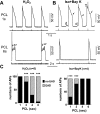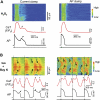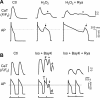Revisiting the ionic mechanisms of early afterdepolarizations in cardiomyocytes: predominant by Ca waves or Ca currents?
- PMID: 22307670
- PMCID: PMC3330805
- DOI: 10.1152/ajpheart.00742.2011
Revisiting the ionic mechanisms of early afterdepolarizations in cardiomyocytes: predominant by Ca waves or Ca currents?
Abstract
Early afterdepolarizations (EADs) have been implicated in severe cardiac arrhythmias and sudden cardiac deaths. However, the mechanism(s) for EAD genesis, especially regarding the relative contribution of Ca(2+) wave (CaW) vs. L-type Ca current (I(Ca,L)), still remains controversial. In the present study, we simultaneously recorded action potentials (APs) and intracellular Ca(2+) images in isolated rabbit ventricular myocytes and systematically compared the properties of EADs in the following two pharmacological models: 1) hydrogen peroxide (H(2)O(2); 200 μM); and 2) isoproterenol (100 nM) and BayK 8644 (50 nM) (Iso + BayK). We assessed the rate dependency of EADs, the temporal relationship between EADs and corresponding CaWs, the distribution of EADs over voltage, and the effects of blockers of I(Ca,L), Na/Ca exchangers, and ryanodine receptors. The most convincing evidence came from the AP-clamp experiment, in which the cell membrane clamp was switched from current clamp to voltage clamp using a normal AP waveform without EAD; CaWs disappeared in the H(2)O(2) model, but persisted in the Iso + BayK model. We postulate that, although CaWs and reactivation of I(Ca,L) may act synergistically in either case, reactivation of I(Ca,L) plays a predominant role in EAD genesis under oxidative stress (H(2)O(2) model), while spontaneous CaWs are a predominant cause for EADs under Ca(2+) overload condition (Iso + BayK model).
Figures







Similar articles
-
Burst emergence of intracellular Ca2+ waves evokes arrhythmogenic oscillatory depolarization via the Na+-Ca2+ exchanger: simultaneous confocal recording of membrane potential and intracellular Ca2+ in the heart.Circ Res. 2008 Aug 29;103(5):509-18. doi: 10.1161/CIRCRESAHA.108.176677. Epub 2008 Jul 17. Circ Res. 2008. PMID: 18635824
-
Oxidative-stress-induced afterdepolarizations and calmodulin kinase II signaling.Circ Res. 2009 Jan 2;104(1):79-86. doi: 10.1161/CIRCRESAHA.108.183475. Epub 2008 Nov 26. Circ Res. 2009. PMID: 19038865 Free PMC article.
-
Calcium-voltage coupling in the genesis of early and delayed afterdepolarizations in cardiac myocytes.Biophys J. 2015 Apr 21;108(8):1908-21. doi: 10.1016/j.bpj.2015.03.011. Biophys J. 2015. PMID: 25902431 Free PMC article.
-
Cardiomyocytes hypertrophic status after myocardial infarction determines distinct types of arrhythmia: role of the ryanodine receptor.Prog Biophys Mol Biol. 2010 Sep;103(1):71-80. doi: 10.1016/j.pbiomolbio.2010.01.002. Epub 2010 Jan 28. Prog Biophys Mol Biol. 2010. PMID: 20109482 Review.
-
Early afterdepolarizations in cardiac myocytes: beyond reduced repolarization reserve.Cardiovasc Res. 2013 Jul 1;99(1):6-15. doi: 10.1093/cvr/cvt104. Epub 2013 Apr 25. Cardiovasc Res. 2013. PMID: 23619423 Free PMC article. Review.
Cited by
-
The electromechanical window is no better than QT prolongation to assess risk of Torsade de Pointes in the complete atrioventricular block model in dogs.Br J Pharmacol. 2014 Feb;171(3):714-22. doi: 10.1111/bph.12483. Br J Pharmacol. 2014. PMID: 24490860 Free PMC article.
-
New antiarrhythmic targets to control intracellular calcium handling.Neth Heart J. 2014 May;22(5):198-213. doi: 10.1007/s12471-014-0549-5. Neth Heart J. 2014. PMID: 24733689 Free PMC article.
-
Phospholamban Ablation Using CRISPR/Cas9 System Improves Mortality in a Murine Heart Failure Model.PLoS One. 2016 Dec 16;11(12):e0168486. doi: 10.1371/journal.pone.0168486. eCollection 2016. PLoS One. 2016. PMID: 27992596 Free PMC article.
-
Imaging ROS signaling in cells and animals.J Mol Med (Berl). 2013 Aug;91(8):917-27. doi: 10.1007/s00109-013-1067-4. Epub 2013 Jul 20. J Mol Med (Berl). 2013. PMID: 23873151 Free PMC article. Review.
-
Beta-Adrenoceptor Stimulation Reveals Ca2+ Waves and Sarcoplasmic Reticulum Ca2+ Depletion in Left Ventricular Cardiomyocytes from Post-Infarction Rats with and without Heart Failure.PLoS One. 2016 Apr 20;11(4):e0153887. doi: 10.1371/journal.pone.0153887. eCollection 2016. PLoS One. 2016. PMID: 27096943 Free PMC article.
References
-
- Bechem M, Hoffmann H. The molecular mode of action of the Ca agonist (−)BAY K 8644 on the cardiac Ca channel. Pflügers Arch 424: 343–353, 1993 - PubMed
-
- Binah O, Rosen MR. Mechanisms of ventricular arrhythmias. Circulation 85: I25–31, 1992 - PubMed
-
- Birinyi P, Acsai K, Banyasz T, Toth A, Horvath B, Virag L, Szentandrassy N, Magyar J, Varro A, Fulop F, Nanasi PP. Effects of SEA0400 and KB-R7943 on Na+/Ca2+ exchange current and L-type Ca2+ current in canine ventricular cardiomyocytes. Naunyn Schmiedebergs Arch Pharmacol 372: 63–70, 2005 - PubMed
Publication types
MeSH terms
Substances
Grants and funding
LinkOut - more resources
Full Text Sources
Miscellaneous

